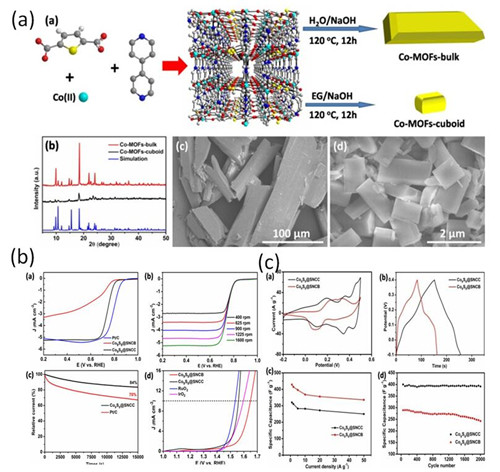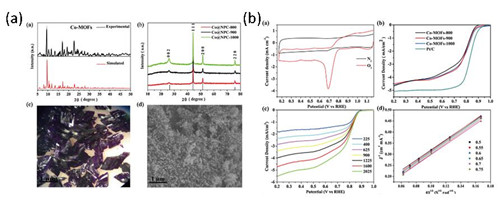Figure 1. (a) Morphology and compositional characterization of Co/Ni bimetallic MOFs and their derived materials; (b) Capacitance performance testing and application stability. Figure 2. (a) S and N contain Co-MOFs morphology and structure characterization; (b) Oxygen catalytic reaction performance and application stability; (c) Capacitance performance testing and application stability. Figure 3. (a) Morphology and structural characterization of Co-MOFs and their pyrolysis products; (b) Electrocatalytic performance testing of the prepared materials. Recently, the Institute of Solid State Physics, Institute of Solid State Physics, Chinese Academy of Sciences has made new progress in the construction and application of high performance supercapacitors and electrocatalytic electrode materials. The relevant results are in full text in Journal of Materials Chemistry A (J. Mater. Chem. A 5, 9873-9881 (2017)), Inorganic Chemistry Frontiers (Inorg. Chem. Front. 4, 491-498 (2017) and Applied Surface. Published on Science (Appl. Surf. Sci. 392, 402-409 (2017)). Metal-organic frameworks (MOFs) generally refer to compounds formed by the self-assembly process of organic ligands and metal ions containing nitrogen/oxygen and other elements, and have ultra-high specific surface, rich components, and easy to adjust pore structure. With many advantages such as unsaturated coordination sites, it has gradually become a research hotspot in the field of electrochemical energy conversion and storage. However, the poor electrical conductivity of MOFs materials and their instability in aqueous solution lead to poor electrochemical performance. In recent years, people have developed various methods to obtain MOFs and their derived materials that are more excellent in conductivity and stability. For example, MOFs are compounded with high-conductivity polymers such as graphene and carbon nanotubes. Chemical modification of the surface of the MOFs is performed using a ligand having a plurality of benzene ring plane conjugated structures, and direct high-temperature pyrolysis to convert to a corresponding carbon-based material. MOFs can obtain a metal/oxide/carbide/nitride porous carbon composite structure with high electrochemical activity and high electrical conductivity in a single step by high temperature thermal reduction, and make in-situ doping of S, N, and other elements possible. The MOFs have become ideal precursors for the preparation of non-precious metal/porous carbon composite electrode materials during the synthesis process. In summary, the researchers used cobalt and nickel metal salts and two ligands containing S and N to synthesize two-dimensional sheet-like Co/Ni bimetallic MOFs at room temperature, and then used Co/Ni MOFs. As a template, ultra-fine CoNi alloy nanoparticles supported S,N co-doped porous graphite carbon composites were obtained by pyrolysis reduction. Studies have shown that composite materials constructed using this method have excellent electrical conductivity, high capacitance storage capacity, and good cycle performance, as shown in Figure 1. The composite material not only retains the two-dimensional structure of the MOFs precursor, but also has a high specific surface area and a uniform dispersion of active sites. The ultra-fine CoNi alloy nanoparticles and the porous graphitic carbon can also be used as electron collectors to increase the conductivity of the material. . Similarly, researchers have also developed S, N co-doped Co-MOFs nanostructures, and further pyrolysis to obtain Co9S8/S, N-doped porous carbon composites, which exhibited as oxygen reactive electrocatalysts and capacitor electrode materials. Excellent application performance, as shown in Figure 2. In addition, the researchers used cobalt salt as a metal source and trimellitic acid as an organic ligand. Triethylamine accelerated the coordination of metal ions and organic ligands and provided a nitrogen source. Large-scale Co was prepared under hydrothermal conditions. -The MOFs material, after one-step pyrolysis, obtained a composite of elemental Co nanoparticles and N-doped porous graphitic carbons, and exhibited higher electrochemical catalytic activity in electrocatalytic water decomposition and oxygen reduction, as shown in Fig. 3 . The above research results have important significance for the design, large-scale preparation and application of high-performance energy conversion and storage materials. This work was funded by the Chinese Academy of Sciences 100-person plan, the National Natural Science Foundation, and the International Innovation Team Project. Ffp2 Kn95 Face Mask,Ppf2 Protective Cup Mask,Kn95 Protective Cup Mask,Ppf2 Protective Fold Flat Mask Jiangmen anjian biotechnology co. LTD , https://www.anjianmask.com

